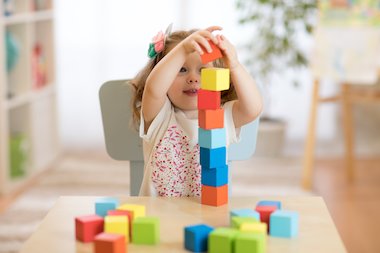Schemas in the Early Years Setting
- Supports home learning
Add to My Folder
Schemas are a pattern of repeated behaviours in children that are regularly demonstrated during play. They reflect the way that young children explore and learn about how the world works. They are initiated by the child and are often a reflection of the child’s interests.

Many adults, including parents, have never heard of schemas, but we actually display behaviours similar to schemas all the time. A schema is simply ‘a pattern of repeated actions. Clusters of schemas develop into later concepts’ (Athey, 2007). For example, Jason makes a slice of toast with jam, he puts the bread in the toaster for one minute and then butters it and layers it with jam. In the past, he found that putting the toast in for three minutes was far too long and the toast was too crispy for his liking. He also found that putting the jam on before the butter didn’t produce the taste that he liked. Over time, Jason created a mental model of the best and most efficient way to make toast. This process happened through trial and error until he came up with a method that suited him best. This process of trial and error is similar to what children do when learning about the way the world works. Observing schemas in children is like witnessing young scientists with investigations in action. Children are trying things out, repeating actions, making errors and then adapting what they do and retrying until they find a way that works for them.
There are lots of types of schemes and in this article we will explore some of the most common: the trajectory schema, the positioning schema, the transporting schema, the enveloping schema, the connecting schema, the rotating schema, the transforming schema and the orienteering schema.
Understanding schemas is useful for adults who work with young children. It will help you to understand why your children behave in certain ways and will help with your planning. It is important to remember that a child’s exploration of their natural urges is developmentally appropriate and should not be misinterpreted as negative. Familiarity with the Characteristics of Effective Learning will support practitioners’ deeper understanding of the different types of skills and learning that occurs when a child is going through a schema.
Trajectory Schema
Dropping, rolling, throwing, jumping and moving things in lines: these may all be signs of a child in the trajectory schema. It may involve the moving of objects, or a child might have a fascination with jumping from one place to another or throwing objects! It’s not surprising that this schema is sometimes misinterpreted as negative behaviour. It is the adults’ role to try and understand this and to think about how they can enable the child to explore this schema in a safe and positive way.
Obviously some of the urges in this schema, like jumping from chairs or throwing hard objects, may be unsafe for the child and others around them. Adults should still set rules but also offer alternatives that work with the child’s interests. Have the right space and equipment to make your area safe for exploration and be prepared with objects that are safe and that won’t break when they fall or are thrown (for example, balls made of foam or plastic, pompoms or soft toys).
Activity Ideas for Trajectory Schema
- Invite the child to take turns throwing their toy into containers that have been placed at varying distances.
- Provide different objects like balls, wheeled objects and tins for children to explore rolling.
- Have available blocks, bottles or skittles that the child can bowl down.
- Have different objects or materials that can perform as a ramps and bridges, for example, cardboard, sanded wood offcuts, carpet tubes and clean guttering. Children can explore the movement of different objects like cars, balls and toys. They can investigate how moving the heights of the ramps and bridges affect the movement of the object.
- Invite the children to fill bottles with varying amounts of sand or water and roll the bottles sideways down ramp. Children can explore how to make some of the bottles move slower or faster.
- Children can use paintbrushes or paint rollers dipped in water and explore making line marks on concrete floors.
- Invite children to drop different objects from various heights and discuss how they move. For example, can the children tell you which object is more bouncy?
Positioning Schema
Already a member? Sign in below.
Published 10 February 2020
Reviews
You need to be signed in to place a review.